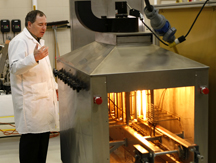Radiant fried chicken patties versus traditional: split decision
July 30, 2013
 |
|
Kevin Keener, a Purdue University professor of food science, demonstrates the radiant fryer in a campus lab. (Purdue Agricultural Communication file photo/Tom Campbell)) |
WEST LAFAYETTE, Ind. – Panelists' preferences in a taste test were nearly equally divided between chicken patties fried in a radiant fryer developed by a Purdue University researcher and those fried in a conventional oil immersion fryer, a Purdue study showed.
While panelists preferred the flavor and less oily texture of the radiant-fried patties, they preferred the crispiness and appearance of immersion-fried chicken patties. Panelists were split on their overall preference: 34 favored the radiant-fried patty, and 33 selected the immersion-fried patty. One panelist did not indicate a preference.
"The key is that consumers are showing a willingness to eat food products cooked with a radiant fryer," said Kevin Keener, a professor in the Department of Food Science. "In some instances, they prefer characteristics that the radiant fryer can develop."
Keener and two colleagues developed and patented the radiant frying system in 2007. The radiant fryer uses infrared energy to produce the appealing crispy exterior unique to fried food.
Sixty-eight panelists were recruited on the basis of age, preference for fried chicken products, and a habit of eating "fast food" at least two times a month. The group consisted of students, employees and visitors of the Department of Food Science. Panelists rated randomly numbered samples of chicken patties on the basis of flavor, crispiness, oiliness, appearance and overall preference.
This was the first study to compare the properties and consumer appeal of radiant fried and oil immersion fried chicken patties. It was also the first to use the new pilot scale radiant fryer, which has 10 independent radiant heating zones, compared with five zones in the previous laboratory model. Adjustable halogen "emitters" heat partially-fried food products as they are conveyed through the fryer.
Because the fryer requires no additional oil, radiant fried food has less fat and fewer calories than foods finished in an oil bath. The radiant fryer can produce chicken patties with 16 percent less fat and 19 percent more moisture than oil immersion-fried patties.
Along with the health benefits, reducing oil cuts down on waste, cost and the safety hazards associated with handling hot oil, Keener said. It also can result in better tasting food.
"When you bite into a fried food, about 80 percent of what you taste is oil," Keener said. "The oil masks the flavor. When we start removing the oil, people are amazed at how much of the underlying product they can taste."
Forty of the 68 participants rated the radiant-fried patties as tastier than oil immersion-fried patties.
Keener envisions a radiant fryer product line with flavored foods such as cheddar cheese hash browns and barbeque chicken.
Designing products specifically for the radiant fryer would ensure more uniform frying results. Researchers currently are limited to testing foods that have been formulated for an oil immersion fryer.
One challenge to the success of the radiant fryer is consumer reaction, which can be difficult to predict. Though the radiant fryer produced chicken patties with equivalent crust thickness to those fried in oil, 48 out of 68 panelists rated the oil immersed patties as crispier, sending researchers back to fine-tune the frying profile and product design.
"Crispiness is a solvable problem," said Keener. "We can now go back and make adjustments to these products, working with the manufacturers to meet consumers' expectations."
The results of the preference test suggest that radiant frying could be a viable alternative to oil immersion frying, said Louis Nelson III, lead author of the report.
"From a statistical standpoint, there was no difference in panelists' overall preference," said Nelson, a doctoral student in food process engineering.
The study is available on the website of the journal LWT – Food Science and Technology at http://www.sciencedirect.com/science/article/pii/S0023643813001011. It is to be published in a print version in October.
A video showing the radiant fryer oven in operation can be viewed at http://youtu.be/xrpj4IpibcM
Writer: Natalie van Hoose, 765-496-2050, nvanhoos@purdue.edu
Sources: Kevin Keener, 765-494-6648, kkeener@purdue.edu
Louis Nelson III, 352-875-6989, lnelsoni@purdue.edu
ABSTRACT
Comparison of the FryLess 100 K Radiant Fryer to oil immersion frying
Louis V. Nelson III 1; Kevin M. Keener 2; Kaitlin R. Kaczay 2; Preetha Banerjee 2; Jean L. Jensen 2; Andrea Liceaga 2
1 Dept. of Agricultural and Biological Engineering, Purdue University, West Lafayette, Indiana, USA
2 Dept. of Food Science, Purdue University, West Lafayette, Indiana, USA
E-mail: lnelsoni@purdue.edu
With limited success, numerous attempts have been made to reduce the fat content of oil immersion fried foods, while maintaining their unique characteristics. A recent advancement in frying is dynamic radiant frying. Radiant frying utilizes infrared energy to reproduce the heating profile generated during oil immersion frying without oil immersion, the result being a fried food with a crispy surface and similar temperature profile to immersion fried with significantly less oil. The goal of this study was to compare frozen, consumer-ready chicken patties, fried using the FryLess 100 K Radiant Fryer, and oil immersion frying, respectively. Properties compared included core and surface temperatures, oil content, moisture content, color, and peak shear force. Significant differences (P < 0.01) were observed in color, oil content, and moisture content. Radiant fried patties were slightly lighter in color and had an average of 16% less oil and 19% more moisture than the immersion fried. Sensory evaluation revealed that panelists preferred the flavor and less oily mouthfeel of the radiant fried patties, but preferred the crispness and appearance of the immersion fried patties. Panelists indicated no difference in overall preference, signifying that radiant frying may serve as a viable alternative to oil immersion frying of some chicken products.
Ag Communications: (765) 494-2722;
Keith Robinson, robins89@purdue.edu
Agriculture News Page

